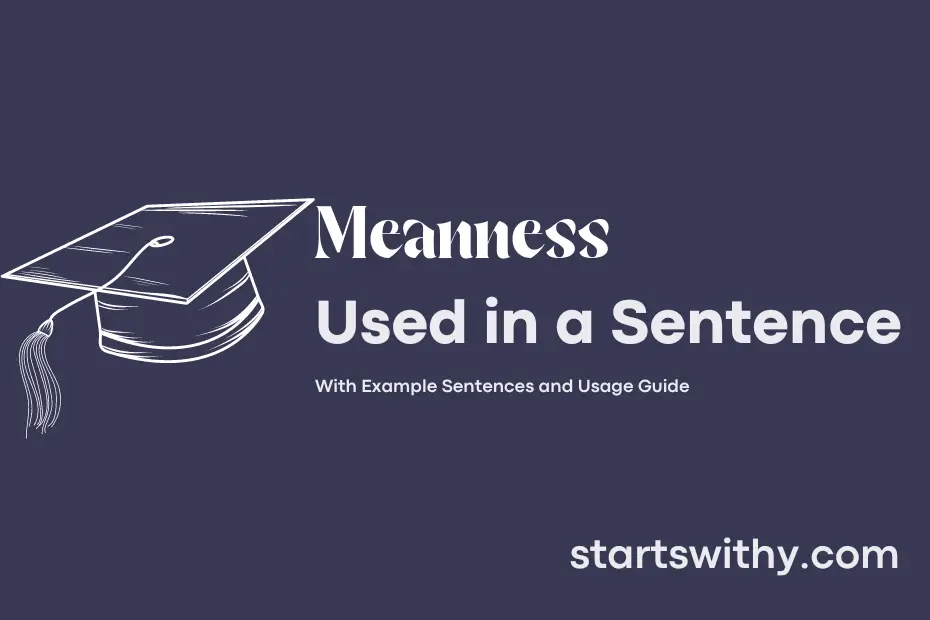Have you ever encountered words or actions filled with cruelty or hostility? This negative quality, known as meanness, is often characterized by a lack of kindness or empathy towards others.
Meanness can manifest in various forms, from hurtful comments and behaviors to intentional actions that aim to belittle or harm others. Recognizing the signs of meanness can help us navigate interpersonal interactions and protect ourselves from toxic influences.
7 Examples Of Meanness Used In a Sentence For Kids
- Meanness is when we don’t share our toys with friends.
- When someone says unkind words, it shows meanness.
- We should always be kind and avoid meanness.
- Meanness is when we exclude someone from playing with us.
- Let’s choose kindness over meanness every day.
- Helping others instead of showing meanness makes us happy.
- Remember, meanness never leads to good friendships.
14 Sentences with Meanness Examples
- Meanness can often be found in competitive group projects when some members refuse to share their research or help others.
- During exam season, some students resort to meanness by deliberately giving false information to classmates to trick them.
- It’s important to address any instances of meanness in classroom discussions so that everyone feels comfortable speaking up without fear of judgment.
- Some students show meanness by spreading rumors or gossiping about their peers to gain social power within their friend groups.
- Meanness can be seen in unfair grading practices by professors who play favorites or show bias towards certain students.
- Joining study groups can be beneficial, but watch out for any signs of meanness such as withholding study materials or sabotaging study sessions.
- Some students display meanness by purposefully excluding others from social events or group activities to assert dominance within a social circle.
- It’s important to differentiate between harmless teasing and hurtful meanness in conversations with friends to maintain a healthy relationship with peers.
- Coercing classmates into sharing their study notes by using intimidation tactics is a form of meanness that can create unnecessary tension within a college community.
- Students should be wary of individuals who exhibit meanness in online forums or classroom discussions by engaging in cyberbullying or making hurtful comments.
- Participating in gossiping or engaging in judgmental behavior towards fellow students can create an atmosphere of meanness in college campuses.
- Some students display meanness by belittling their peers’ achievements or downplaying their successes to elevate their own status within academic circles.
- Academic pressure can sometimes lead to acts of meanness such as sabotaging a classmate’s project to diminish their chances of success.
- Peer pressure can sometimes result in acts of meanness as students may feel compelled to go along with negative behavior to fit in with a certain group.
How To Use Meanness in Sentences?
When using the word “Meanness” in a sentence, it is important to understand its meaning and context. Meanness refers to being unkind, malicious, or hurtful towards others. Here is a guide on how to properly incorporate meanness into a sentence:
-
Subject-Verb-Object Structure: Use meanness as the subject, verb, or object in a sentence. For example: “Her meanness towards her classmates was evident in her hurtful remarks.”
-
Adjective Modifier: Meanness can be preceded by an adjective to provide more context. For instance: “The cruel meanness of his actions left a lasting impact on her.”
-
Preposition Usage: Meanness can also be used with prepositions to indicate relationships between words. For example: “His meanness towards his colleagues resulted in a toxic work environment.”
-
Conjunctions: You can also use conjunctions to connect sentences with meanness. For example: “She apologized for her meanness, but the damage had already been done.”
By following these guidelines, beginners can effectively incorporate meanness into their sentences while maintaining clarity and coherence. Remember to always consider the context in which you are using the word to convey your message accurately.
Conclusion
In various examples of sentences with “meanness,” it is evident that this trait can be displayed in acts, words, or behavior that is intentionally cruel, unkind, or hurtful towards others. Whether it is teasing a friend with unnecessarily harsh comments or spreading rumors to damage someone’s reputation, meanness has negative impacts on relationships and overall well-being.
By being mindful of our words and actions, we can choose kindness over meanness, fostering a more positive and supportive environment. Practicing empathy, understanding, and compassion can help counteract the effects of meanness, creating a harmonious and respectful community where individuals feel valued and supported. Ultimately, replacing meanness with kindness can lead to stronger connections and a more fulfilling life for everyone involved.



